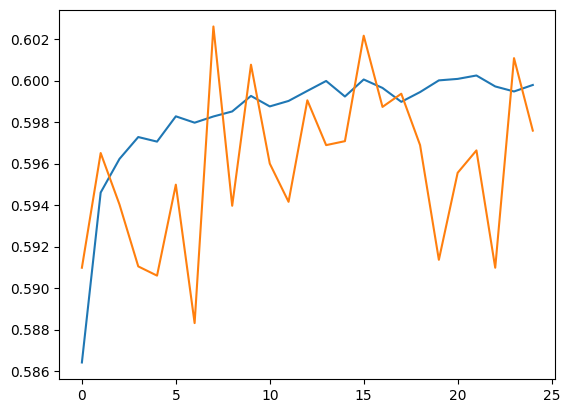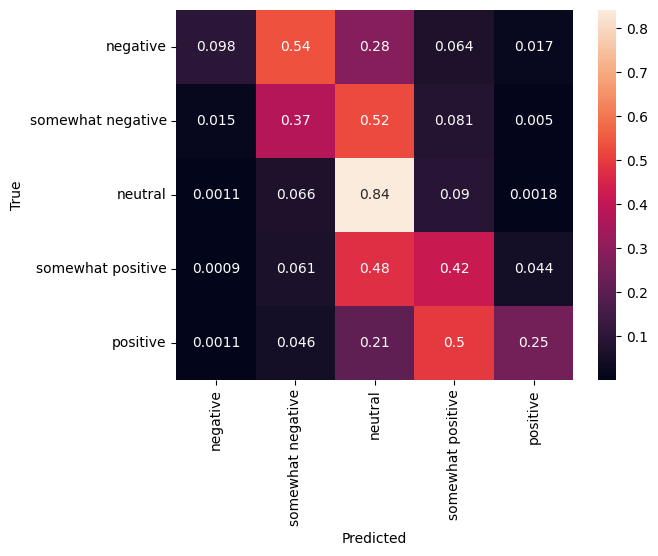 عرض على TensorFlow.org عرض على TensorFlow.org |  تشغيل في Google Colab تشغيل في Google Colab |  عرض على جيثب عرض على جيثب |  تحميل دفتر تحميل دفتر |  انظر نموذج TF Hub انظر نموذج TF Hub |
TF-المحور هو منبر لتبادل الخبرات والتعلم الآلي وتعبئتها في موارد قابلة لإعادة الاستخدام، وحدات خصوصا قبل المدربين. في هذا البرنامج التعليمي ، سوف نستخدم وحدة تضمين نص TF-Hub لتدريب مصنف بسيط للمشاعر بدقة أساسية معقولة. ثم سنرسل التنبؤات إلى Kaggle.
لتعليمي أكثر تفصيلا على تصنيف النص مع TF-المحور واتخاذ مزيد من الخطوات لتحسين دقة، نلقي نظرة على تصنيف النص مع TF-المحور .
يثبت
pip install -q kaggle
import tensorflow as tf
import tensorflow_hub as hub
import matplotlib.pyplot as plt
import numpy as np
import pandas as pd
import seaborn as sns
import zipfile
from sklearn import model_selection
وبما أن هذا البرنامج التعليمي سوف تستخدم مجموعة بيانات من Kaggle، فإنه يتطلب تهيئة API رمز لحساب Kaggle الخاص بك، وتحميلها على البيئة Colab.
import os
import pathlib
# Upload the API token.
def get_kaggle():
try:
import kaggle
return kaggle
except OSError:
pass
token_file = pathlib.Path("~/.kaggle/kaggle.json").expanduser()
token_file.parent.mkdir(exist_ok=True, parents=True)
try:
from google.colab import files
except ImportError:
raise ValueError("Could not find kaggle token.")
uploaded = files.upload()
token_content = uploaded.get('kaggle.json', None)
if token_content:
token_file.write_bytes(token_content)
token_file.chmod(0o600)
else:
raise ValueError('Need a file named "kaggle.json"')
import kaggle
return kaggle
kaggle = get_kaggle()
ابدء
البيانات
سنحاول حل تحليل المشاعر على الفيلم مراجعات مهمة من Kaggle. تتكون مجموعة البيانات من عبارات فرعية نحوية لمراجعات فيلم Rotten Tomatoes. وتتمثل المهمة في تسمية العبارات بأنها سلبية أو إيجابية على مقياس من 1 إلى 5.
يجب عليك قبول قواعد المنافسة قبل أن تتمكن من استخدام API لتحميل البيانات.
SENTIMENT_LABELS = [
"negative", "somewhat negative", "neutral", "somewhat positive", "positive"
]
# Add a column with readable values representing the sentiment.
def add_readable_labels_column(df, sentiment_value_column):
df["SentimentLabel"] = df[sentiment_value_column].replace(
range(5), SENTIMENT_LABELS)
# Download data from Kaggle and create a DataFrame.
def load_data_from_zip(path):
with zipfile.ZipFile(path, "r") as zip_ref:
name = zip_ref.namelist()[0]
with zip_ref.open(name) as zf:
return pd.read_csv(zf, sep="\t", index_col=0)
# The data does not come with a validation set so we'll create one from the
# training set.
def get_data(competition, train_file, test_file, validation_set_ratio=0.1):
data_path = pathlib.Path("data")
kaggle.api.competition_download_files(competition, data_path)
competition_path = (data_path/competition)
competition_path.mkdir(exist_ok=True, parents=True)
competition_zip_path = competition_path.with_suffix(".zip")
with zipfile.ZipFile(competition_zip_path, "r") as zip_ref:
zip_ref.extractall(competition_path)
train_df = load_data_from_zip(competition_path/train_file)
test_df = load_data_from_zip(competition_path/test_file)
# Add a human readable label.
add_readable_labels_column(train_df, "Sentiment")
# We split by sentence ids, because we don't want to have phrases belonging
# to the same sentence in both training and validation set.
train_indices, validation_indices = model_selection.train_test_split(
np.unique(train_df["SentenceId"]),
test_size=validation_set_ratio,
random_state=0)
validation_df = train_df[train_df["SentenceId"].isin(validation_indices)]
train_df = train_df[train_df["SentenceId"].isin(train_indices)]
print("Split the training data into %d training and %d validation examples." %
(len(train_df), len(validation_df)))
return train_df, validation_df, test_df
train_df, validation_df, test_df = get_data(
"sentiment-analysis-on-movie-reviews",
"train.tsv.zip", "test.tsv.zip")
Split the training data into 140315 training and 15745 validation examples.
train_df.head(20)
تدريب نموذج
class MyModel(tf.keras.Model):
def __init__(self, hub_url):
super().__init__()
self.hub_url = hub_url
self.embed = hub.load(self.hub_url).signatures['default']
self.sequential = tf.keras.Sequential([
tf.keras.layers.Dense(500),
tf.keras.layers.Dense(100),
tf.keras.layers.Dense(5),
])
def call(self, inputs):
phrases = inputs['Phrase'][:,0]
embedding = 5*self.embed(phrases)['default']
return self.sequential(embedding)
def get_config(self):
return {"hub_url":self.hub_url}
model = MyModel("https://tfhub.dev/google/nnlm-en-dim128/1")
model.compile(
loss = tf.losses.SparseCategoricalCrossentropy(from_logits=True),
optimizer=tf.optimizers.Adam(),
metrics = [tf.keras.metrics.SparseCategoricalAccuracy(name="accuracy")])
history = model.fit(x=dict(train_df), y=train_df['Sentiment'],
validation_data=(dict(validation_df), validation_df['Sentiment']),
epochs = 25)
Epoch 1/25 4385/4385 [==============================] - 16s 3ms/step - loss: 1.0237 - accuracy: 0.5869 - val_loss: 1.0023 - val_accuracy: 0.5870 Epoch 2/25 4385/4385 [==============================] - 15s 3ms/step - loss: 0.9995 - accuracy: 0.5941 - val_loss: 0.9903 - val_accuracy: 0.5952 Epoch 3/25 4385/4385 [==============================] - 15s 3ms/step - loss: 0.9946 - accuracy: 0.5967 - val_loss: 0.9811 - val_accuracy: 0.6011 Epoch 4/25 4385/4385 [==============================] - 15s 3ms/step - loss: 0.9924 - accuracy: 0.5971 - val_loss: 0.9851 - val_accuracy: 0.5935 Epoch 5/25 4385/4385 [==============================] - 15s 3ms/step - loss: 0.9912 - accuracy: 0.5988 - val_loss: 0.9896 - val_accuracy: 0.5934 Epoch 6/25 4385/4385 [==============================] - 15s 3ms/step - loss: 0.9896 - accuracy: 0.5984 - val_loss: 0.9810 - val_accuracy: 0.5936 Epoch 7/25 4385/4385 [==============================] - 15s 3ms/step - loss: 0.9892 - accuracy: 0.5978 - val_loss: 0.9845 - val_accuracy: 0.5994 Epoch 8/25 4385/4385 [==============================] - 15s 3ms/step - loss: 0.9889 - accuracy: 0.5996 - val_loss: 0.9772 - val_accuracy: 0.6015 Epoch 9/25 4385/4385 [==============================] - 15s 3ms/step - loss: 0.9880 - accuracy: 0.5992 - val_loss: 0.9798 - val_accuracy: 0.5991 Epoch 10/25 4385/4385 [==============================] - 15s 3ms/step - loss: 0.9879 - accuracy: 0.6002 - val_loss: 0.9869 - val_accuracy: 0.5935 Epoch 11/25 4385/4385 [==============================] - 15s 3ms/step - loss: 0.9878 - accuracy: 0.5998 - val_loss: 0.9790 - val_accuracy: 0.5985 Epoch 12/25 4385/4385 [==============================] - 14s 3ms/step - loss: 0.9871 - accuracy: 0.5999 - val_loss: 0.9845 - val_accuracy: 0.5964 Epoch 13/25 4385/4385 [==============================] - 15s 3ms/step - loss: 0.9871 - accuracy: 0.6001 - val_loss: 0.9800 - val_accuracy: 0.5947 Epoch 14/25 4385/4385 [==============================] - 15s 3ms/step - loss: 0.9873 - accuracy: 0.6001 - val_loss: 0.9810 - val_accuracy: 0.5934 Epoch 15/25 4385/4385 [==============================] - 14s 3ms/step - loss: 0.9865 - accuracy: 0.5988 - val_loss: 0.9824 - val_accuracy: 0.5898 Epoch 16/25 4385/4385 [==============================] - 15s 3ms/step - loss: 0.9865 - accuracy: 0.5993 - val_loss: 0.9779 - val_accuracy: 0.5974 Epoch 17/25 4385/4385 [==============================] - 15s 3ms/step - loss: 0.9866 - accuracy: 0.5991 - val_loss: 0.9785 - val_accuracy: 0.5972 Epoch 18/25 4385/4385 [==============================] - 15s 3ms/step - loss: 0.9863 - accuracy: 0.6001 - val_loss: 0.9803 - val_accuracy: 0.5991 Epoch 19/25 4385/4385 [==============================] - 16s 4ms/step - loss: 0.9863 - accuracy: 0.5996 - val_loss: 0.9773 - val_accuracy: 0.5957 Epoch 20/25 4385/4385 [==============================] - 15s 3ms/step - loss: 0.9862 - accuracy: 0.5995 - val_loss: 0.9744 - val_accuracy: 0.6009 Epoch 21/25 4385/4385 [==============================] - 15s 3ms/step - loss: 0.9861 - accuracy: 0.5997 - val_loss: 0.9787 - val_accuracy: 0.5968 Epoch 22/25 4385/4385 [==============================] - 15s 3ms/step - loss: 0.9855 - accuracy: 0.5998 - val_loss: 0.9794 - val_accuracy: 0.5976 Epoch 23/25 4385/4385 [==============================] - 14s 3ms/step - loss: 0.9861 - accuracy: 0.5998 - val_loss: 0.9778 - val_accuracy: 0.5966 Epoch 24/25 4385/4385 [==============================] - 15s 3ms/step - loss: 0.9860 - accuracy: 0.5999 - val_loss: 0.9831 - val_accuracy: 0.5912 Epoch 25/25 4385/4385 [==============================] - 14s 3ms/step - loss: 0.9858 - accuracy: 0.5999 - val_loss: 0.9780 - val_accuracy: 0.5977
تنبؤ
قم بتشغيل التنبؤات لمجموعة التحقق ومجموعة التدريب.
plt.plot(history.history['accuracy'])
plt.plot(history.history['val_accuracy'])
[<matplotlib.lines.Line2D at 0x7f62684da090>]

train_eval_result = model.evaluate(dict(train_df), train_df['Sentiment'])
validation_eval_result = model.evaluate(dict(validation_df), validation_df['Sentiment'])
print(f"Training set accuracy: {train_eval_result[1]}")
print(f"Validation set accuracy: {validation_eval_result[1]}")
4385/4385 [==============================] - 14s 3ms/step - loss: 0.9834 - accuracy: 0.6007 493/493 [==============================] - 1s 2ms/step - loss: 0.9780 - accuracy: 0.5977 Training set accuracy: 0.6006770730018616 Validation set accuracy: 0.5976500511169434
الارتباك مصفوفة
آخر إحصائية مثيرة جدا للاهتمام، وخاصة بالنسبة للمشاكل multiclass، هو مصفوفة الارتباك . تسمح مصفوفة الارتباك بتصور نسبة الأمثلة المصنفة بشكل صحيح وغير صحيح. يمكننا أن نرى بسهولة إلى أي مدى يكون المصنف لدينا متحيزًا وما إذا كان توزيع الملصقات أمرًا منطقيًا. من الناحية المثالية ، يجب توزيع الجزء الأكبر من التنبؤات على طول القطر.
predictions = model.predict(dict(validation_df))
predictions = tf.argmax(predictions, axis=-1)
predictions
<tf.Tensor: shape=(15745,), dtype=int64, numpy=array([1, 1, 2, ..., 2, 2, 2])>
cm = tf.math.confusion_matrix(validation_df['Sentiment'], predictions)
cm = cm/cm.numpy().sum(axis=1)[:, tf.newaxis]
sns.heatmap(
cm, annot=True,
xticklabels=SENTIMENT_LABELS,
yticklabels=SENTIMENT_LABELS)
plt.xlabel("Predicted")
plt.ylabel("True")
Text(32.99999999999999, 0.5, 'True')

يمكننا بسهولة إرسال التنبؤات مرة أخرى إلى Kaggle عن طريق لصق الكود التالي في خلية كود وتنفيذها:
test_predictions = model.predict(dict(test_df))
test_predictions = np.argmax(test_predictions, axis=-1)
result_df = test_df.copy()
result_df["Predictions"] = test_predictions
result_df.to_csv(
"predictions.csv",
columns=["Predictions"],
header=["Sentiment"])
kaggle.api.competition_submit("predictions.csv", "Submitted from Colab",
"sentiment-analysis-on-movie-reviews")
بعد تقديم، تحقق المتصدرين لنرى كيف فعلت.
